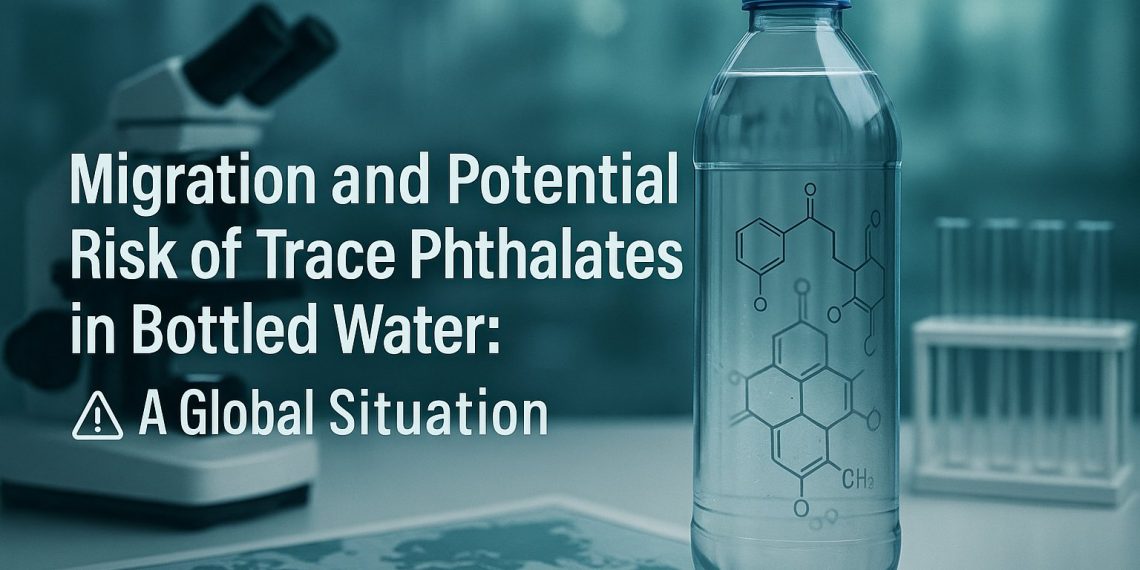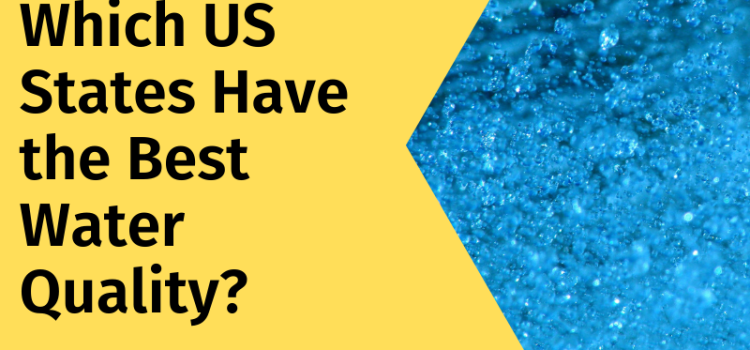Last updated on June 2nd, 2025 at 12:26 pm
Phthalates are synthetic chemical compounds used as plasticizers to increase the flexibility, transparency, durability, and longevity of plastics. They are widely used in polyethylene terephthalate (PET) bottles, the most common packaging material for bottled water globally. These chemicals are not chemically bound to plastics, making them susceptible to migration into bottled contents, especially under certain storage conditions.
The presence of trace phthalates in bottled water has raised alarms among scientists, regulatory bodies, and health organizations due to their endocrine-disrupting properties and potential carcinogenicity. The migration of these compounds into bottled water is not only a localized issue but a global concern.
Read: The Most Effective Way to Eliminate PFAS and PFOA from Your Drinking Water
Mechanisms of Phthalate Migration into Bottled Water
Phthalate migration primarily occurs due to temperature fluctuations, prolonged storage, UV exposure, and chemical interactions between the water and the plastic polymer matrix. Factors contributing to increased phthalate release include:
- Storage at elevated temperatures (above 25°C)
- Exposure to sunlight or UV radiation
- Long shelf life, particularly in tropical regions
- Mechanical stress during transportation
- Improper bottle sealing and manufacturing defects
Studies have confirmed that under such conditions, bottled water contains measurable amounts of diethyl phthalate (DEP), dibutyl phthalate (DBP), di(2-ethylhexyl) phthalate (DEHP), and other derivatives.
Global Occurrence and Surveillance Data
North America
In the United States and Canada, the FDA and Health Canada set guidelines for permissible levels of DEHP in drinking water. However, independent research has documented trace phthalate levels exceeding regulatory thresholds in bottled water brands stored in warm climates or in direct sunlight.
Europe
European Union (EU) countries maintain stricter regulations under REACH and EFSA standards. Nevertheless, surveillance studies in countries like Italy, France, and Germany have detected phthalate presence in more than 60% of tested PET bottled water samples.
Asia-Pacific
India, China, and Indonesia have reported elevated levels of DBP and DEHP, particularly in locally bottled water subjected to poor storage standards. High ambient temperatures and lack of regulation enforcement contribute to significant migration risks.
Africa and Latin America
In regions with high environmental temperatures and limited regulatory oversight, bottled water consumers face substantial exposure to trace phthalates. Informal bottling units and roadside vendors are especially problematic.
Read: EPA Sets First Federal Limits on Dangerous ‘Forever Chemicals’ in Drinking Water
Health Risks Associated with Trace Phthalates in Bottled Water
Endocrine Disruption
Phthalates mimic or block hormones such as estrogen and testosterone, disrupting the human endocrine system. Even at low concentrations, long-term exposure can lead to:
- Hormonal imbalances
- Reduced fertility in both men and women
- Premature puberty in children
- Increased risk of breast cancer and prostate disorders
Developmental and Neurological Impacts
Prenatal and childhood exposure to phthalates has been associated with:
- Reduced IQ levels
- Attention deficit disorders
- Behavioral abnormalities
- Autism spectrum-related symptoms
Reproductive and Fetal Toxicity
Studies link phthalate ingestion to:
- Testicular dysgenesis syndrome
- Miscarriage risk
- Impaired sperm quality
- Urogenital malformations in newborns
Potential Carcinogenicity
The International Agency for Research on Cancer (IARC) has classified DEHP as a possible human carcinogen (Group 2B). Continuous ingestion via bottled water poses a long-term cancer risk, especially for vulnerable populations.
Regulatory Frameworks and Global Limits on Phthalates
| Country/Region | Regulatory Agency | Max Allowable DEHP (µg/L) |
| USA | FDA | 6 |
| EU | EFSA | 8 |
| WHO | Guidelines for Drinking-water Quality | 8 |
| Canada | Health Canada | 14 |
| Australia | NHMRC | 8 |
However, most countries do not mandate routine testing of bottled water for all phthalate types. Existing policies are often outdated and lack enforcement at the distribution level.
Read: 7 Science-Backed Advantages of Drinking Purified Water
Scientific Studies Confirming Phthalate Migration
Numerous peer-reviewed studies have provided solid evidence of phthalate migration:
- A study published in Environmental Science & Technology found DEHP concentrations up to 3.2 µg/L in bottled water stored in sunlight for 45 days.
- In Journal of Hazardous Materials, Indian researchers detected DBP levels of 0.94 µg/L in popular bottled brands under tropical storage.
- European Food Safety Authority (EFSA) concluded that chronic dietary exposure to phthalates may exceed the tolerable daily intake in specific population segments.
Mitigation Strategies: Reducing Exposure to Phthalates
Consumer-Level Actions
- Avoid storing bottled water in hot environments
- Use glass or stainless-steel reusable bottles
- Check expiration dates and manufacturing location
- Do not reuse PET bottles multiple times
Industry-Level Solutions
- Shift to phthalate-free PET resins
- Incorporate barrier layers inside bottles to prevent leaching
- Improve supply chain refrigeration and transport practices
- Implement real-time monitoring of chemical migration
Governmental and Regulatory Interventions
- Mandate labeling of phthalate content on bottles
- Enforce stricter migration testing protocols
- Develop global harmonized standards for bottled water packaging
- Promote public awareness campaigns on plastic safety
The Path Forward: Global Collaboration and Innovation
Addressing the global threat of trace phthalates in bottled water requires coordinated action among governments, manufacturers, and consumers. Innovation in sustainable packaging materials, widespread analytical testing adoption, and transparency in manufacturing practices are essential steps toward a safer future.
As the world shifts toward health-conscious consumption, ensuring the chemical safety of bottled water is not optional—it is imperative. We must continue to raise awareness, support research, and demand accountability from stakeholders involved in bottled water production and regulation.
Read: Water Stress: A Global Problem That’s Getting Worse
Conclusion
The migration and potential risks of trace phthalates in bottled water present a significant, global public health concern. With evidence mounting across continents, now is the time for robust policy action, technological reform, and informed consumer behavior. Protecting the purity of bottled water must be a priority—not just for today, but for the health of generations to come.











Thank you for your sharing. I am worried that I lack creative ideas. It is your article that makes me full of hope. Thank you. But, I have a question, can you help me? https://www.binance.com/si-LK/register?ref=V2H9AFPY
Your article helped me a lot, is there any more related content? Thanks!
Подарок для конкурента http://xrumer.xyz/
В работе несколько програм.
Есть оптовые тарифы
changan uni характеристики https://changan-v-spb.ru
Entdecken Sie die besten Weinverkostungen in Wien auf [url=https://weinverkostung.neocities.org/]wine tasting vienna[/url].
Besucher konnen hier erstklassige Weine in malerischer Umgebung probieren.
Die Weinverkostungen in Wien sind perfekt fur Kenner und Neulinge. Viele Veranstaltungen werden von erfahrenen Sommeliers begleitet.
#### **2. Die besten Orte fur Weinverkostungen**
In Wien gibt es zahlreiche Lokale und Weinguter, die Verkostungen anbieten. Auch moderne Weinkeller in der Innenstadt bieten exklusive Erlebnisse.
Einige Winzer veranstalten Fuhrungen durch ihre Kellereien. Dabei erfahren Besucher mehr uber die Herstellung der Weine.
#### **3. Wiener Weinsorten und ihre Besonderheiten**
Wiener Weine sind vor allem fur ihre Vielfalt bekannt. Auch der fruchtige Grune Veltliner zahlt zu den bekanntesten Wei?weinen der Region.
Die Bodenbeschaffenheit und das Klima pragen den Geschmack. Dank nachhaltiger Anbaumethoden ist die Qualitat stets hoch.
#### **4. Tipps fur eine gelungene Weinverkostung**
Eine gute Vorbereitung macht die Verkostung noch angenehmer. Es empfiehlt sich, langsam zu trinken, um die Nuancen zu schmecken.
Gruppenverkostungen bringen zusatzlichen Spa?. Gemeinsames Diskutieren uber die Aromen fordert den Austausch.
—
### **Spin-Template fur den Artikel**
#### **1. Einfuhrung in die Weinverkostung in Wien**
Viele Veranstaltungen werden von erfahrenen Sommeliers begleitet.
#### **2. Die besten Orte fur Weinverkostungen**
In Wien gibt es zahlreiche Lokale und Weinguter, die Verkostungen anbieten.
#### **3. Wiener Weinsorten und ihre Besonderheiten**
Die Bodenbeschaffenheit und das Klima pragen den Geschmack.
#### **4. Tipps fur eine gelungene Weinverkostung**
Gruppenverkostungen bringen zusatzlichen Spa?.
[url=https://dzialki-beskidy.pl/]vavada casino pl[/url]
Inwestycja w dzialke w tym regionie to doskonaly sposob na polaczenie przyjemnego z pozytecznym.
Dzieki rozwijajacej sie infrastrukturze i rosnacemu zainteresowaniu turystow, ceny dzialek stopniowo wzrastaja. Coraz wiecej osob docenia spokoj i piekno przyrody, jakie oferuja Beskidy.
#### **2. Gdzie szukac najlepszych ofert dzialek?**
Wybor odpowiedniej lokalizacji zalezy od indywidualnych potrzeb i budzetu. Portal dzialki-beskidy.pl oferuje szeroki wybor nieruchomosci w roznych cenach.
Przed zakupem nalezy dokladnie przeanalizowac dostepnosc mediow i warunki zabudowy. Wazne jest, aby sprawdzic, czy dzialka ma dostep do wody i pradu, co wplywa na wygode uzytkowania.
#### **3. Jakie korzysci daje posiadanie dzialki w Beskidach?**
Nieruchomosc w gorach to nie tylko inwestycja finansowa, ale rowniez szansa na poprawe jakosci zycia. Mozna tu zbudowac dom letniskowy i cieszyc sie urokami przyrody przez caly rok.
Dodatkowo, region ten oferuje wiele atrakcji, takich jak szlaki turystyczne i stoki narciarskie. Beskidy to idealne miejsce dla tych, ktorzy cenia aktywny tryb zycia i bliskosc natury.
#### **4. Jak przygotowac sie do zakupu dzialki?**
Przed podjeciem decyzji warto skonsultowac sie z prawnikiem i geodeta. Wizyta na miejscu i rozmowa z sasiadami moga dostarczyc cennych informacji o okolicy.
Wazne jest rowniez okreslenie swojego budzetu i planow zwiazanych z zagospodarowaniem terenu. Niektore oferty pozwalaja na rozlozenie platnosci, co ulatwia inwestycje.
—
### **Szablon Spinu**
**1. Dlaczego warto kupic dzialke w Beskidach?**
– Beskidy to idealne miejsce dla osob szukajacych spokoju i bliskosci natury.
– Rosnaca popularnosc tego regionu przeklada sie na wzrost wartosci nieruchomosci.
**2. Gdzie szukac najlepszych ofert dzialek?**
– Dobrym rozwiazaniem jest skorzystanie ze sprawdzonych stron internetowych, takich jak dzialki-beskidy.pl.
– Warto porownac rozne oferty, aby znalezc najbardziej oplacalna inwestycje.
**3. Jakie korzysci daje posiadanie dzialki w Beskidach?**
– Wlasny kawalek gorskiej przestrzeni pozwala na ucieczke od miejskiego zgielku.
– Region oferuje wiele aktywnosci, od wedrowek po gorach po jazde na nartach.
**4. Jak przygotowac sie do zakupu dzialki?**
– Konsultacja z geodeta pomoze uniknac problemow z granicami nieruchomosci.
– Niektore oferty umozliwiaja elastyczne formy platnosci, co moze byc korzystne.